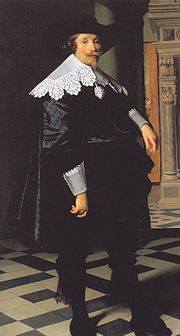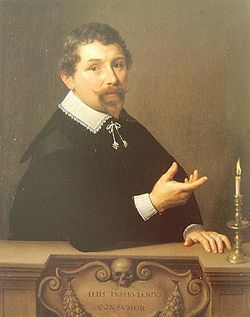
Nicolaes Eliaszoon Pickenoy
Encyclopedia


Netherlands
The Netherlands is a constituent country of the Kingdom of the Netherlands, located mainly in North-West Europe and with several islands in the Caribbean. Mainland Netherlands borders the North Sea to the north and west, Belgium to the south, and Germany to the east, and shares maritime borders...
painter of Flemish
Flanders
Flanders is the community of the Flemings but also one of the institutions in Belgium, and a geographical region located in parts of present-day Belgium, France and the Netherlands. "Flanders" can also refer to the northern part of Belgium that contains Brussels, Bruges, Ghent and Antwerp...
origin. Pickenoy was possibly a pupil of Cornelis van der Voort
Cornelis van der Voort
Cornelis van der Voort or van der Voorde was a Dutch Golden Age portrait painter from the early 17th century.-Life:...
and presumably Bartholomeus van der Helst
Bartholomeus van der Helst
Bartholomeus van der Helst was a Dutch portrait painter.-Biography:Born in Haarlem, the son of a Haarlem innkeeper, Van der Helst moved to Amsterdam some time before 1636, for he was married there in that year...
was his own pupil.
Life
He was the son of the Antwerp monumental mason Elias Claeszoon Pickenoy (1565-1640) and Heijltje Laurens s'Jonge (1562-1638), who emigrated to AmsterdamAmsterdam
Amsterdam is the largest city and the capital of the Netherlands. The current position of Amsterdam as capital city of the Kingdom of the Netherlands is governed by the constitution of August 24, 1815 and its successors. Amsterdam has a population of 783,364 within city limits, an urban population...
before Nicolaes Pickenoy was born. In 1621, living near the Oude Kerk, he married Levijntje Bouwens (1599-na 1656), an orphan of 21 years. They had ten children: Sara and Elias died young.
Pickenoy painted large Schuttersstukken, group portraits of the regents
Regenten
In the 16th, 17th and 18th centuries, the regenten were the rulers of the Dutch Republic, the leaders of the Dutch cities or the heads of organisations . Though not formally a hereditary "class", they were de facto "patricians", comparable to that ancient Roman class...
of the orphanage, and individual portraits of local or national celebrities like Nicolaes Tulp
Nicolaes Tulp
Nicolaes Tulp was a Dutch surgeon and mayor of Amsterdam. Tulp was well known for his upstanding moral character.-Life:...
, Cornelis de Graeff
Cornelis de Graeff
Cornelis de Graeff, also Cornelis de Graeff van Polsbroek was the most illustrious member of the De Graeff family. He was a mayor of Amsterdam from the Dutch Golden Age and a powerful Amsterdam regent after the sudden death of stadholder William II of Orange...
, Maarten Harpertszoon Tromp and Jochem Hendrickszoon Swartenhont
Jochem Hendrickszoon Swartenhont
Jochem Hendricksz Swartenhont was a Dutch naval officer in the navy of the Dutch Republic from the 17th century....
, Elisabeth Bas
Elisabeth Bas
Elisabeth Bas was a figure in the Dutch Republic. She was the wife of Jochem Hendrickszoon Swartenhont....
's husband. The earliest picture ascribed to the artist is "Dr. Sebastiaen Egbertz de Vrij's Osteological Presentation" of 1619, now in Amsterdam Historisch Museum. His heyday was ca. 1630-1637, a period marked by a high artistic level and numerous commissions from prominent patrons. After 1637 he painted little, save for a number of prestigious—and lucrative—group portraits. Besides portraits, he also painted a small number of biblical subjects, one of which can be seen in the Museum Catharijneconvent
Museum Catharijneconvent
The Museum Catharijneconvent is a national museum of religious art in Utrecht. It is located in the former Catharijneconvent, having been sited there since 1979. Its collections include those of the museum of religious art of the Catholic Archbishopric of Utrecht, located in the convent until...
. The Rijksmuseum Amsterdam and Amsterdams Historisch Museum
Amsterdams Historisch Museum
The Amsterdam Museum, until 2011 called the Amsterdams Historisch Museum, is a museum about the history of Amsterdam. Since 1975, it is located in the old city orphanage between Kalverstraat and Nieuwezijds Voorburgwal.-History:...
holds many of his best works, not least the Schutterstukken or militia paintings.
In 1637 he bought from Adriaen Pauw the house on the corner of Sint Anthoniessluis and Jodenbreestraat, a fashionable area with many painters, art dealers, jewellers and so on. The house had previously been owned by his supposed master, Cornelis van der Voort
Cornelis van der Voort
Cornelis van der Voort or van der Voorde was a Dutch Golden Age portrait painter from the early 17th century.-Life:...
, and later by Hendrick van Uylenburgh
Hendrick van Uylenburgh
Hendrick van Uylenburgh was an influential Dutch Golden Age art dealer who helped launch the careers of Rembrandt, Govert Flinck, Ferdinand Bol and other painters....
. During the years 1631–1634 the latter was collaborating with Rembrandt van Rijn, who painted numerous portraits for Van Uylenburgh's art business. Thus the house Pickenoy purchased had been a centre of Amsterdam portraiture for decades. In 1639 Rembrandt returned to the neighbourhood as he bought the house next to Pickenoys, the present day Rembrandthuis
Rembrandt House Museum
The Rembrandt House Museum is a house in Jodenbreestraat in Amsterdam, Netherlands, where Rembrandt lived and painted for a number of years. It is now a museum...
. Rembrandt could leave his house via an exit onto the Zwanenburgwal under the house of his neighbor Pickenoy. He brought out Night Watch
Night Watch (painting)
Night Watch or The Night Watch or The Shooting Company of Frans Banning Cocq is the common name of one of the most famous works by Dutch painter Rembrandt van Rijn....
—painted in his courtyard—rolled up through the tunnel. Like Rembrandt, Pickenoy was not able to bring up the loan and so after eight years he sold the house.
The work of Pickenoy is difficult to distinguish from that of some of his contemporaries. Typical of Pickenoy are the fiercely invading light that makes the heads stand out sharply, the somewhat exaggerated gestures, the large greenish brown shadows and the odd-shaped eyes.
External links
- Four portraits in the Rijksmuseum
- The corporalship of captain Jan Claesz Vlooswijck
- RKD Artist's entry on Pickenoy, with link to numerous images
- Works and literature on Nicolaes Eliasz. Pickenoy
Sources
- Oosthoek's Geïllustreerde Encyclopaedie (1917)
- Dudok van Heel, S.A.C. (1985) De schilder Nicolaes Eliasz. Pickenoy en zijn familie; Liber Amicorum voor Jhr M.C.C. van Valkenburg, pp. 152-60.
- Kaaring, David Burmeister: "Nicolaes Eliasz Pickenoy (1588-1650/56) and Portraiture in Amsterdam around 1620-45", in: SMK Art Journal 2005, 127-137 http://www.smk.dk/smk.nsf/23e5e39594c064ee852564ae004fa010/e4504649048de009c125724300481f0e/$FILE/DavidKaaringJournal2005ENG.pdf.(For illustrations see: "Nicolaes Eliasz Pickenoy (1588-1650/56) og den amsterdamske portrætkunst, ca. 1620-45", SMK Art Journal 2005, 60-81)http://www.smk.dk/smk.nsf/23e5e39594c064ee852564ae004fa010/e4504649048de009c125724300481f0e/$FILE/DavidKaaringJournal2005.pdf

